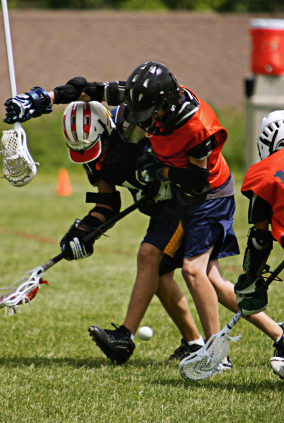While playing sports clearly benefit boys, sports participation is accompanied by a number of problems:
- Pressure leads to risk-taking. As William Pollack, author of Real Boys' Voices, observes, the "pressure on boys to fulfill traditional rules about masculinity can often feel overwhelming. It can lead him to tease, bully or abuse others. It can cause him to make mistakes in how he treats girls and young women and become compulsive about seeking out sex. It can push him to drink alcohol and take drugs. It can prod him toward depression,... It may even lead him to frightful, sometimes lethal acts of aggression and violence. In almost all cases it makes him want to limit the range of his personal expression or silence his genuine inner voice entirely."

- Pressure to conform to gender stereotype. Team sports encourage boys to conform to masculine stereotypes and traits such as aggression and toughness, playing in pain, and stoicism, and socialize them into traditional gender roles. "A failure to display aggressiveness and self-abandonment desired by coaches and teammates subjects adolescent [male] athletes frequently to suggestions that they are feminine or homosexual," notes Eli Newberger, M.D., in his book, The Men They Will Become. "Without doubt," Newberger argues, "this denigration of the feminine contributes to the potential for male athletes to be manipulative and exploitative in their relationships with real females." Echoes Dr. Emily Senay in her book, From Boys to Men, the "macho risk-taking culture that surrounds competitive sports in high school ... leads [boys] to ... act in sexist, disrespectful and sometimes violent ways towards women and others."
- Teaches violence as acceptable behavior. The masculine, heterosexual culture of many athletic programs (particularly in male contact sports like football and hockey) may teach boys to view off-the-field violence as an acceptable means of maintaining their identities as athletes.
- Linked to alcohol abuse. While some studies show that teens participating in sports report lower use of alcohol than those who are not involved in sports activities,1 the culture of sports leads some male athletes to abuse alcohol and routinely violate no-drinking rules, with other studies of working- and middle-class youth fiding that sports participation is linked to higher alcohol use.2
- Jock culture. Those who identify as "jocks" report significantly more misconduct (e.g. skipping school, cutting classes, having someone from home called to the school for disciplinary purposes, and being sent to the principle's office) than non-jocks.3 Because the "jock culture" at most high schools affords male athletes special status - not only among their peers but in the wider school and local community - they are prone to developing an attitude that they are above the rules.
- Often involves hazing. Rigid and confining social expectations about masculine and feminine behavior and homophobia tend to work in tandem to create a climate in which boys are likely to feel compelled to participate in violent and often demeaning hazing practices.
Adapted from the book, Home Team Advantage: The Critical Role of Mothers in Youth Sports (HarperCollins ) by Brooke de Lench. de Lench is also the Founding Executive Director of MomsTeam Institute and the publisher of MomsTeam.com. Producer of: The Smartest Team: Making High School Football Safer (PBS) and is well known as the “Mother of Youth Sports Safety” for her tireless advocacy and solutions based work in safeguarding young athletes.
1. Rosewater, Ann. "Learning to Play and Playing to Learn: Organized Sports and Educational Outcomes" ("Learning to Play"), citing Fredricks, J.A. & Eccles, J.S. "Is extracurricular participation associated with beneficial outcomes? Concurrent and longitudinal relations." Developmental Psychology 42(4), 698-713 (2006). A study of predominantly African Americans found that athletic participation was associated with lower drug use and alcohol use for boys. Id.
2. Learning to Play, citing Barber, B.L., Eccles, J.S. & Stone, M.R. "Whatever happened to the jock, the brain, and the princess? Young adult pathways linked to adolescent activity involvement and social identity." Journal of Adolescent Research, 16, 429-455 (2001).
3. Learning to Play, citing Miller, K.E. et. al. "Untangling the links among athletic involvement, gender, race, and adolescent academic outcomes." Sociology of Sport Journal, 23, 178-193 (2005).
Updated June 7, 2016









